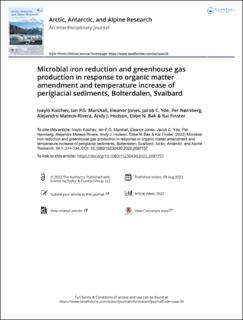| dc.contributor.author | Kolchev, Ivaylo | |
| dc.contributor.author | Marshall, Ian P.G. | |
| dc.contributor.author | Jones, Eleanor | |
| dc.contributor.author | Yde, Jacob C. | |
| dc.contributor.author | Nørnberg, Per | |
| dc.contributor.author | Mateos-Rivera, Alejandro | |
| dc.contributor.author | Hodson, Andrew | |
| dc.contributor.author | Bak, Ebbe N. | |
| dc.contributor.author | Finster, Kai | |
| dc.date.accessioned | 2023-03-08T14:31:43Z | |
| dc.date.available | 2023-03-08T14:31:43Z | |
| dc.date.created | 2022-09-13T10:42:55Z | |
| dc.date.issued | 2022 | |
| dc.identifier.citation | Kolchev, I., Marshall, I. P. G., Jones, E., Yde, J. C., Nørnberg, P., Mateos-Rivera, A., Hodson, A. J., Bak, E. N., & Finster, K. (2022). Microbial iron reduction and greenhouse gas production in response to organic matter amendment and temperature increase of periglacial sediments, Bolterdalen, Svalbard. Arctic, Antarctic, and Alpine Research, 54(1), 314-334. | en_US |
| dc.identifier.issn | 1523-0430 | |
| dc.identifier.uri | https://hdl.handle.net/11250/3057146 | |
| dc.description.abstract | Arctic permafrost soils store substantial reserves of organic matter (OM) from which microbial transformation contributes significantly to greenhouse gas emissions of CH4 and CO2. However, many younger sediments exposed by glacier retreat and sea level change in fjord landscapes lack significant organic carbon resources, so their capacity to promote greenhouse gas emissions is unclear. We therefore studied the effects of increased temperatures (4°C and 21°C) and OM on rates of Fe(III) reduction, CO2 production, and methanogenesis in three different Holocene sedimentary units from a single site within the former marine limit of Adventdalen, Svalbard. Higher temperature and OM addition generally stimulated CH4 production and CO2 production and an increase in Bacteria and Archaea abundance in all units, whereas an equal stimulation of Fe(II) production by OM amendment and an increase in temperature to 21°C was only observed in a diamicton. We observed an accumulation of Fe(II) in beach and delta deposits as well but saw no stimulating effect of additional OM or increased temperature. Interestingly, we observed a small but significant production of CH4 in all units despite the presence of large reservoirs of Fe(III), sulfate, and nitrate, indicating either the availability of substrates that are primarily used by methanogens or a tight physical coupling between fermentation and methanogenesis by direct electron transfer. Our study clearly illustrates a significant challenge that comes with the large heterogeneity on a narrow spatial scale that one encounters when studying soils that have complex histories. | en_US |
| dc.language.iso | eng | en_US |
| dc.publisher | Taylor & Francis | en_US |
| dc.rights | Navngivelse 4.0 Internasjonal | * |
| dc.rights.uri | http://creativecommons.org/licenses/by/4.0/deed.no | * |
| dc.title | Microbial iron reduction and greenhouse gas production in response to organic matter amendment and temperature increase of periglacial sediments, Bolterdalen, Svalbard | en_US |
| dc.type | Peer reviewed | en_US |
| dc.type | Journal article | en_US |
| dc.description.version | publishedVersion | en_US |
| dc.rights.holder | © 2022 The Author(s). | en_US |
| dc.source.pagenumber | 314-334 | en_US |
| dc.source.volume | 54 | en_US |
| dc.source.journal | Arctic, Antarctic and Alpine research | en_US |
| dc.source.issue | 1 | en_US |
| dc.identifier.doi | 10.1080/15230430.2022.2097757 | |
| dc.identifier.cristin | 2051106 | |
| dc.relation.project | Norges forskningsråd: 244906 | en_US |
| cristin.ispublished | true | |
| cristin.fulltext | original | |
| cristin.qualitycode | 1 | |

